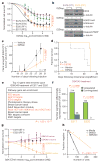Epigenomic alterations define lethal CIMP-positive ependymomas of infancy
- PMID: 24553142
- PMCID: PMC4174313
- DOI: 10.1038/nature13108
Epigenomic alterations define lethal CIMP-positive ependymomas of infancy
Abstract
Ependymomas are common childhood brain tumours that occur throughout the nervous system, but are most common in the paediatric hindbrain. Current standard therapy comprises surgery and radiation, but not cytotoxic chemotherapy as it does not further increase survival. Whole-genome and whole-exome sequencing of 47 hindbrain ependymomas reveals an extremely low mutation rate, and zero significant recurrent somatic single nucleotide variants. Although devoid of recurrent single nucleotide variants and focal copy number aberrations, poor-prognosis hindbrain ependymomas exhibit a CpG island methylator phenotype. Transcriptional silencing driven by CpG methylation converges exclusively on targets of the Polycomb repressive complex 2 which represses expression of differentiation genes through trimethylation of H3K27. CpG island methylator phenotype-positive hindbrain ependymomas are responsive to clinical drugs that target either DNA or H3K27 methylation both in vitro and in vivo. We conclude that epigenetic modifiers are the first rational therapeutic candidates for this deadly malignancy, which is epigenetically deregulated but genetically bland.
Conflict of interest statement
The authors declare no competing financial interests.
Figures





Comment in
-
Cancer: Tumours outside the mutation box.Nature. 2014 Feb 27;506(7489):438-9. doi: 10.1038/nature13061. Epub 2014 Feb 19. Nature. 2014. PMID: 24553138 No abstract available.
References
-
- Taylor MD, et al. Radial glia cells are candidate stem cells of ependymoma. Cancer Cell. 2005;8:323–335. - PubMed
-
- Bouffet E, Foreman N. Chemotherapy for intracranial ependymomas. Childs Nerv Syst. 1999;15:563–570. - PubMed
-
- Bouffet E, et al. Survival benefit for pediatric patients with recurrent ependymoma treated with reirradiation. Int J Radiat Oncol Biol Phys. 2012;83:1541–1548. - PubMed
Publication types
MeSH terms
Substances
Associated data
- Actions
Grants and funding
LinkOut - more resources
Full Text Sources
Other Literature Sources
Medical
Molecular Biology Databases

